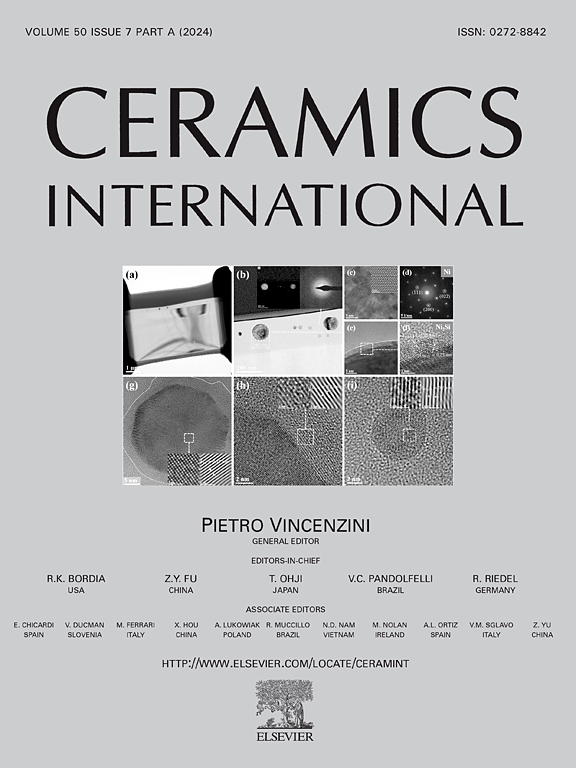The effects of co-implanting strontium (Sr) and helium (He) into SiC at temperatures exceeding the critical amorphization temperature and annealing above 1000 oC
IF 5.6
2区 材料科学
Q1 MATERIALS SCIENCE, CERAMICS
引用次数: 0
Abstract
The structural evolution and migration behaviour of strontium (Sr) in polycrystalline silicon carbide (SiC) co-implanted with helium (He) exceeding 300 °C were investigated at temperatures above 1000 °C. Sr ions were implanted into SiC at 600 °C (denoted as Sr-SiC-600) and co-implanted with He ions at 350 °C (denoted as Sr + He-SiC-600). Both samples were subsequently isochronally annealed at 1100 °C, 1200 °C, and 1300 °C for 5 h. Both as-implanted and annealed were characterized by transmission electron microscopy (TEM), scanning electron microscopy (SEM), atomic force microscopy (AFM), and Rutherford backscattering spectrometry (RBS). Implantation at 600 °C resulted in a defective layer embedded in the crystalline SiC. Co-implantation led to the formation of He platelets in the defective layer, as well as blisters and large voids on the surface accompanied by slight migration of Sr. Annealing the Sr-SiC-600 samples up to 1300 °C resulted in formation of Sr precipitates accompanied by neither migration nor loss. Contrary annealing Sr + He-SiC-600 samples up to 1300 °C resulted in the formation of Sr precipitates accompanied by some loss of Sr. These results indicate trapping of Sr in both samples. This trapping was influenced by thermally activated cavities in the Sr-SiC-600 samples and by He induced cavities in the Sr + He-SiC-600 samples. These findings have significant implications for the design and performance of TRISO fuel particles.
在超过临界非晶化温度和1000℃以上退火条件下,向SiC中共注入锶(Sr)和氦(He)的效果
研究了氦(He)共注入300℃以上的多晶碳化硅(SiC)中锶(Sr)在1000℃以上的结构演化和迁移行为。在600℃下将Sr离子注入SiC(记为Sr-SiC-600),在350℃下与He离子共注入(记为Sr + He-SiC-600)。随后,两种样品分别在1100°C、1200°C和1300°C等时退火5 h。通过透射电子显微镜(TEM)、扫描电子显微镜(SEM)、原子力显微镜(AFM)和卢瑟福后向散射光谱(RBS)对两种样品进行了表征。在600°C下注入导致了缺陷层嵌入到晶体SiC中。共注入导致缺陷层形成He血小板,表面出现水泡和大空隙,并伴有轻微的Sr迁移。将Sr- sic -600样品退火至1300℃,形成Sr析出相,但不伴有迁移和损失。Sr + He-SiC-600样品在1300℃高温下反向退火,形成了Sr析出相,并伴有一定程度的Sr损失。这些结果表明Sr在两种样品中都被捕获。这种俘获受Sr- sic -600样品中的热激活空腔和Sr + He- sic -600样品中的He诱导空腔的影响。这些发现对TRISO燃料颗粒的设计和性能具有重要意义。
本文章由计算机程序翻译,如有差异,请以英文原文为准。
求助全文
约1分钟内获得全文
求助全文
来源期刊

Ceramics International
工程技术-材料科学:硅酸盐
CiteScore
9.40
自引率
15.40%
发文量
4558
审稿时长
25 days
期刊介绍:
Ceramics International covers the science of advanced ceramic materials. The journal encourages contributions that demonstrate how an understanding of the basic chemical and physical phenomena may direct materials design and stimulate ideas for new or improved processing techniques, in order to obtain materials with desired structural features and properties.
Ceramics International covers oxide and non-oxide ceramics, functional glasses, glass ceramics, amorphous inorganic non-metallic materials (and their combinations with metal and organic materials), in the form of particulates, dense or porous bodies, thin/thick films and laminated, graded and composite structures. Process related topics such as ceramic-ceramic joints or joining ceramics with dissimilar materials, as well as surface finishing and conditioning are also covered. Besides traditional processing techniques, manufacturing routes of interest include innovative procedures benefiting from externally applied stresses, electromagnetic fields and energetic beams, as well as top-down and self-assembly nanotechnology approaches. In addition, the journal welcomes submissions on bio-inspired and bio-enabled materials designs, experimentally validated multi scale modelling and simulation for materials design, and the use of the most advanced chemical and physical characterization techniques of structure, properties and behaviour.
Technologically relevant low-dimensional systems are a particular focus of Ceramics International. These include 0, 1 and 2-D nanomaterials (also covering CNTs, graphene and related materials, and diamond-like carbons), their nanocomposites, as well as nano-hybrids and hierarchical multifunctional nanostructures that might integrate molecular, biological and electronic components.
 求助内容:
求助内容: 应助结果提醒方式:
应助结果提醒方式:


